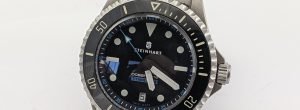Omega Seamaster Automatic cal. 562 service
This early 1960s Seamaster came in performing very poorly and was long overdue for a service. The crown was also feeling very vague in operation when changing the time.

The rear gasket has disintegrated into a black gungy mess which needs to be thoroughly removed from the case.

The movement and dial assembly is removed from the case and, hands removed and then the dial. Another problem is revealed. The setting lever spring is snapped. This controls the in and out movement of the stem between hand setting and winding positions and when broken the crown operation is vague and indistinct. Luckily generic replacements for Omega cal.560 series are available, one of the few parts that are.

The movement is mounted in a holder and next we remove the balance.

Then it's the movement pallet, escape and the movement train.

We are left with the base plate.

Next up is splitting the barrel open and carefully removing the main spring and barrel arbour. The spring is in good shape and just needs a clean.

Into the cleaning machine we go. I use an original 1960s Elma.

Time to start the rebuild. The keyless works are fitted first. Stem, clutch wheel, pinion and the new setting lever spring.

We flip the movement over, the barrel is next and centre wheel.

Mainspring bridge, ratchet wheel next then the movement train, fourth and third wheel and the centre pinion mounted under the centre pinion spring which is tensioned to damp the second hand movement. This is one of the weak points of the 550 series and they wear badly over time leading to a very jumpy second hand movement around the dial.

Then it's the escape wheel, pallet train bridge. Each part is oiled with various grades of synthetic oil either on the pivots or via the jewels once assembled.

Then it's time for the balance assembly. This is the exciting part where we power the watch and see it tick for the first time after its overhaul.

Although the complete balance including the hairspring was thoroughly cleaned in the machine, at this stage I like to remove the balance wheel top and bottom jewels and clean them thoroughly by hand to remove any remaining residue. The jewel splits into pieces allowing the cap jewel to be oiled and remounted on balance pivot, and secured by the lyre spring.

Now it's time to look at the automatic rotor assembly. It's inspected, oiled and reassembled.

Here's the finished movement.

At this stage we can set it up for beat error and rate on the electronic timing machine. The balance wheel is swinging with 242 degrees of amplitude on half power which is OK. A few more slight adjustments to get it closer to specification.

The case is cleaned and a new gasket fitted. Dial and hands reassembled and mounted back in the case.

And we are done, bar some extended testing on the automatic watch winder to check performance over a number of days and make further adjustments if required.


